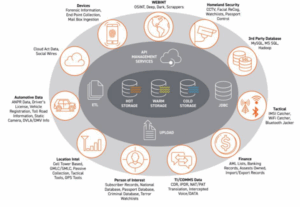Digital society provides a multitude of data-driven clues for analysts across law enforcement and the intelligence community. Intercepted communications content (CC) and metadata are routinely augmented by location data, open source intelligence (OSINT), and a multitude of other sources, from automated license-plate readers and surveillance cameras to the dark web and social media.
Ideally, analysts have the means to structure and correlate this data to provide rich insights that advance their mission, such as to help to obtain search warrants or build evidentiary narratives that prevail in court. In reality, that vision is often defeated by noisy, siloed, unstructured data and disjointed toolsets that interfere with visibility and holistic interpretation. Analysts in such environments are often overwhelmed by data fatigue—cognitive and operational overload that undermines morale and effectiveness.
When analysts lack the tools to drive actionable intelligence from raw data streams, manual triage and analysis can slow down or misdirect investigations and tactical response. Data fatigue increases the likelihood that critical signals will be overcome by ambient noise, threat indicators and insights will be overlooked, and the value of available data will be reduced.
The SS8 end-to-end lawful intelligence platform mitigates data fatigue and its effects by managing and unifying data from every source, as well as efficiently surfacing insights that advance operational objectives. Those capabilities are critical at any investigative scale, from everyday enforcement to building large, complex cases for prosecuting serious and organized crime.
Managing Investigative Data to Release its Value
Lawful intelligence has evolved from monolithic interception of phone calls and perhaps call data records in the wiretapping era to today’s collection and assembly of many minute clues. Unchecked data volumes often force analysts and investigators to consider only a subset of the information available, making informed guesses about where to look next. While the experience and expertise that underlies these judgments is irreplaceable, advanced mechanisms for data management can make them far more efficient and effective.
Mediation and interception from mobile networks alone may require a law-enforcement agency (LEA) to maintain thousands of active targets and hundreds of concurrent calls. That intercepted data is commingled with an array of audio, video, text, and position information that must be orchestrated and unified to make it valuable. Adding to the challenge, agencies commonly build lawful intelligence toolsets organically, by gradually adding point solutions to address new data sources and fill functional gaps in their environments.

Fragmentation is the natural result, with incompatible formats creating data siloes and preventing an overarching view and analysis. Switching among the UIs of multiple tools such as digital forensics, social intelligence, deep or dark web platforms, image analysis engines, and voice analysis platforms puts further obstacles in the paths of analysts, adding to overhead and data fatigue as they work to manually extricate insights.
SS8 MetaHub unifies diverse sources with a common wrapper across all data feeds so they can be interpreted and analyzed holistically from Intellego XT’s single pane of glass. This capability helps eliminate the technical whiplash from swiveling between platforms at the same time as it extends investigative capacity. The SS8 platform scrubs the data to improve its quality, reveals connections across sources, and streamlines analysts’ ability to interrogate the data available to them, transform it into intelligence, and then generate the evidence needed to advance and resolve cases.
Optimizing Operations to Improve Mission-Readiness
Operational challenges tend to become more pronounced as data and data sources get more fragmented. For example, simply identifying the B-party in an encrypted WhatsApp voice session can require an analyst to assemble far-flung bits of information to justify a search warrant. Location intelligence, communication metadata, and many other digital footprints may all play a role, and making that universe of data more coherent can reduce the analyst’s time commitment and increase their chances of success.
In addition to unifying information sources, the SS8 platform streamlines their holistic interpretation with measures such as live data visualizations, target dossiers, relationship analysis, and automated alerts. Going forward, AI and machine learning enhance these capabilities dramatically. Speech-to-text capabilities based on natural language processing parse audio to make it searchable. Visual AI automates recognition of individuals, license plates, and locations at mass scale from collections of images or video. Correlating data points to detect relationships, patterns and anomalies generates insights that human operators often miss and helps direct investigations more effectively.
Better data handling and interpretation at every stage can help streamline investigations by avoiding dead-ends and reducing their impacts. At the same time, every point of access has the potential to expand the scope of inquiry, increasing the challenges to workflow efficiency. The SS8 platform puts a structured toolset at analysts’ fingertips to do horizontal lookup across datasets, interpret and corroborate leads, and minimize the need to switch among tools, generating value instead of fatigue from huge, diverse data stores.
About Kevin McTiernan
 Kevin McTiernan is a seasoned professional with over 20 years of experience in the security industry. His extensive expertise spans big data, cybersecurity, network security analysis, and regulatory compliance. As Vice President of Government Solutions at SS8, Kevin specializes in the implementation of advanced intelligence solutions for the U.S. Government, law enforcement, and the Five Eyes alliance. He is an accomplished public speaker and an adamant supporter and volunteer for the National Child Protection Task Force. You can learn more about Kevin on his LinkedIn profile.
Kevin McTiernan is a seasoned professional with over 20 years of experience in the security industry. His extensive expertise spans big data, cybersecurity, network security analysis, and regulatory compliance. As Vice President of Government Solutions at SS8, Kevin specializes in the implementation of advanced intelligence solutions for the U.S. Government, law enforcement, and the Five Eyes alliance. He is an accomplished public speaker and an adamant supporter and volunteer for the National Child Protection Task Force. You can learn more about Kevin on his LinkedIn profile.
About Rory Quann
 Rory Quann is a Senior Solutions Engineer specializing in End-to-End Government Solutions at SS8 Networks and brings with him over 14 years of experience in the Lawful Interception and Data Analysis industry. Prior to joining SS8 in 2013, Rory worked for BAE System Applied Intelligence where he was focused on large scale Government deployments of Intelligence Solutions. Rory has held multiple positions in the Lawful Intelligence space ranging from Deployment Engineer, System Consultant, and Sales Engineer focusing on Country-wide Passive deployments. Rory is a Certified Microsoft MCSA Engineer and EMC Certified deployment Engineer. Learn more about Rory on his LinkedIn profile here.
Rory Quann is a Senior Solutions Engineer specializing in End-to-End Government Solutions at SS8 Networks and brings with him over 14 years of experience in the Lawful Interception and Data Analysis industry. Prior to joining SS8 in 2013, Rory worked for BAE System Applied Intelligence where he was focused on large scale Government deployments of Intelligence Solutions. Rory has held multiple positions in the Lawful Intelligence space ranging from Deployment Engineer, System Consultant, and Sales Engineer focusing on Country-wide Passive deployments. Rory is a Certified Microsoft MCSA Engineer and EMC Certified deployment Engineer. Learn more about Rory on his LinkedIn profile here.
About SS8 Networks
As a leader in Lawful and Location Intelligence, SS8 is committed to making societies safer. Our mission is to extract, analyze, and visualize critical intelligence, providing real-time insights that help save lives. With 25 years of expertise, SS8 is a trusted partner of the world’s largest government agencies and communication providers, consistently remaining at the forefront of innovation.
Intellego® XT monitoring and data analytics portfolio is optimized for Law Enforcement Agencies to capture, analyze, and visualize complex data sets for real-time investigative intelligence.
LocationWise delivers the highest audited network location accuracy worldwide, providing active and passive location intelligence for emergency services, law enforcement, and mobile network operators.
Xcipio® mediation platform meets the demands of lawful intercept in any network type and provides the ability to transcode (convert) between lawful intercept handover versions and standard families.
To learn more, contact us at info@SS8.com.

